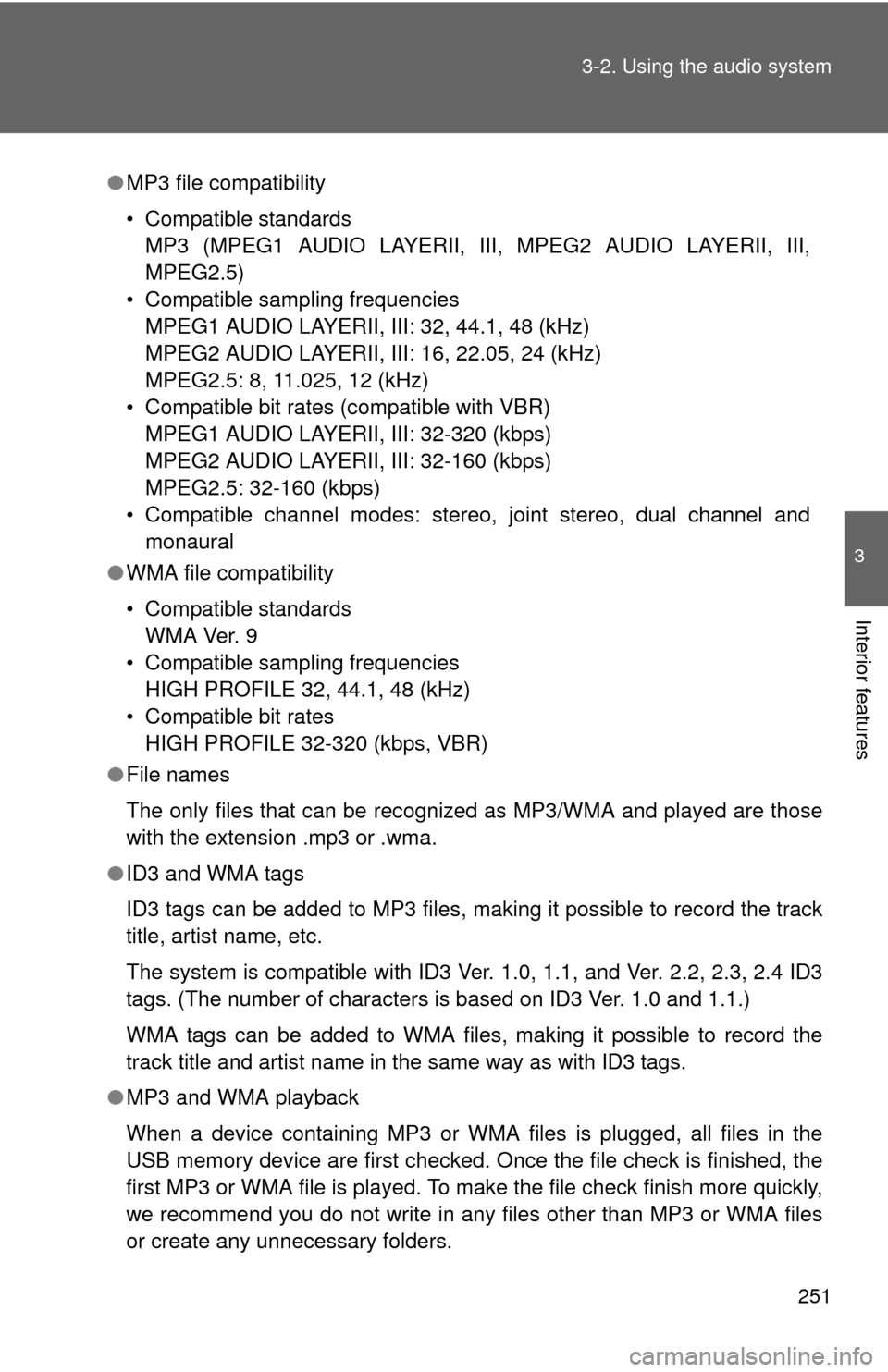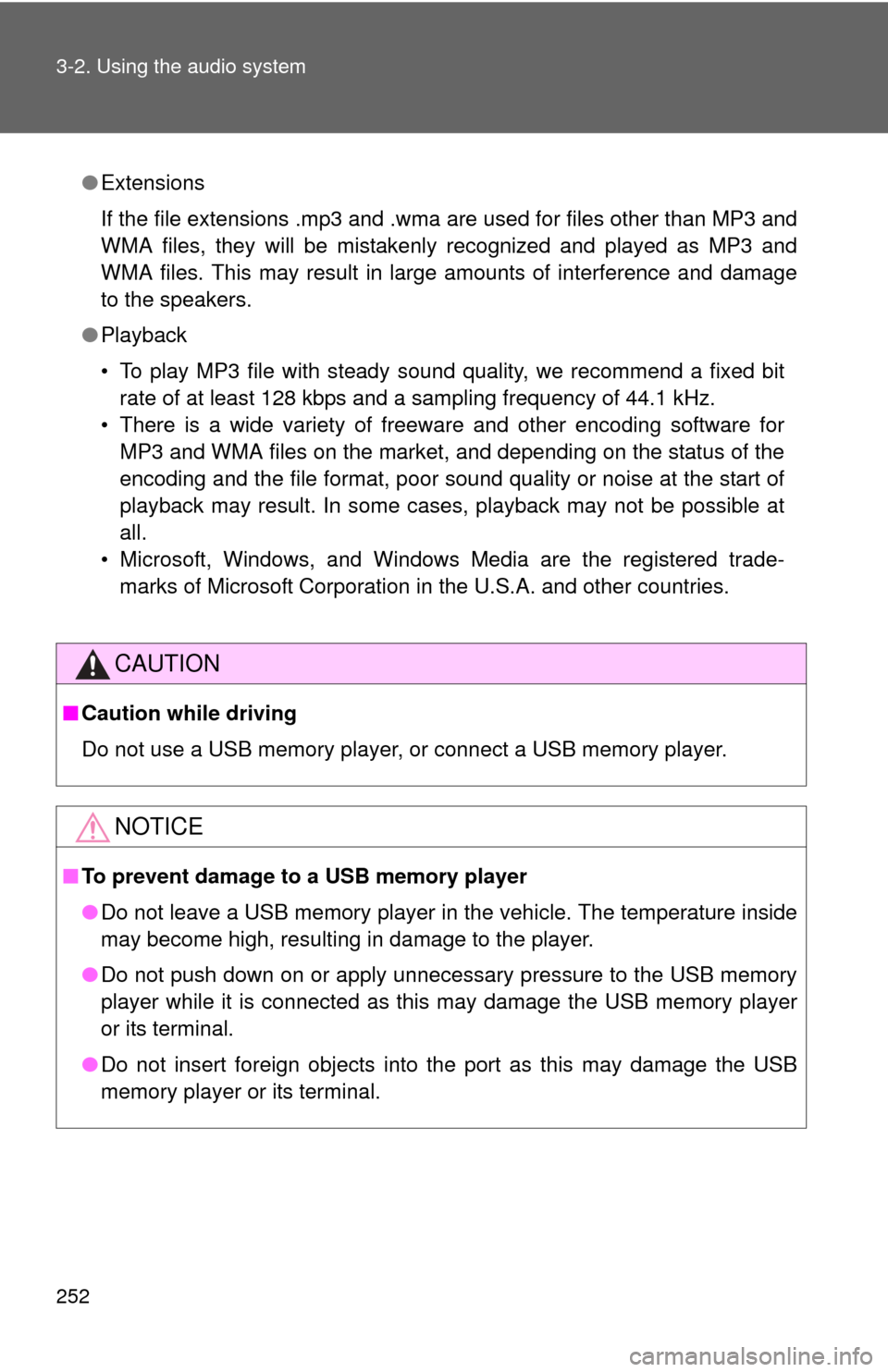Page 252 of 538

250 3-2. Using the audio system
■USB memory player
●Compatible device
USB memory players that can be used for MP3 and WMA playback.
Depending on the type of USB device, playback may not be possible.
● Compatible device formats
The following device formats can be used:
• USB communication formats: USB2.0 FS (12 mbps)
• File formats: FAT16/32 (Windows)
• Correspondence class: Mass storage class
MP3 and WMA files written in any format other than those listed above
may not play correctly, and their file names and folder names may not
be displayed correctly.
Items related to standards and limitations are as follows:
• Maximum directory hierarchy: 8 levels
• Maximum number of folder in device: 999 (including the root)
• Maximum number of files in device: 65,025
• Maximum number of files per folder: 255
● MP3 and WMA files
MP3 (MPEG Audio LAYER 3) is a standard audio compression format.
Files can be compressed to approximately 1/10 of their original size using
MP3 compression.
WMA (Windows Media
TM Audio) is a Microsoft audio compression format.
This format compresses audio data to a size smaller than that of the MP3
format.
There is a limit to the MP3 and WMA file standards that can be used and to
the media/formats on which the files are recorded.
Page 253 of 538

251
3-2. Using the audio system
3
Interior features
●
MP3 file compatibility
• Compatible standards
MP3 (MPEG1 AUDIO LAYERII, III, MPEG2 AUDIO LAYERII, III,
MPEG2.5)
• Compatible sampling frequencies MPEG1 AUDIO LAYERII, III: 32, 44.1, 48 (kHz)
MPEG2 AUDIO LAYERII, III: 16, 22.05, 24 (kHz)
MPEG2.5: 8, 11.025, 12 (kHz)
• Compatible bit rates (compatible with VBR) MPEG1 AUDIO LAYERII, III: 32-320 (kbps)
MPEG2 AUDIO LAYERII, III: 32-160 (kbps)
MPEG2.5: 32-160 (kbps)
• Compatible channel modes: stereo, joint stereo, dual channel and monaural
● WMA file compatibility
• Compatible standards
WMA Ver. 9
• Compatible sampling frequencies HIGH PROFILE 32, 44.1, 48 (kHz)
• Compatible bit rates HIGH PROFILE 32-320 (kbps, VBR)
● File names
The only files that can be recognized as MP3/WMA and played are those
with the extension .mp3 or .wma.
● ID3 and WMA tags
ID3 tags can be added to MP3 files, making it possible to record the track
title, artist name, etc.
The system is compatible with ID3 Ver. 1.0, 1.1, and Ver. 2.2, 2.3, 2.4 ID3
tags. (The number of characters is based on ID3 Ver. 1.0 and 1.1.)
WMA tags can be added to WMA files, making it possible to record the
track title and artist name in the same way as with ID3 tags.
● MP3 and WMA playback
When a device containing MP3 or WMA files is plugged, all files in the
USB memory device are first checked. Once the file check is finished, the
first MP3 or WMA file is played. To make the file check finish more quickly,
we recommend you do not write in any files other than MP3 or WMA files
or create any unnecessary folders.
Page 254 of 538

252 3-2. Using the audio system
●Extensions
If the file extensions .mp3 and .wma are used for files other than MP3 and
WMA files, they will be mistakenly recognized and played as MP3 and
WMA files. This may result in large amounts of interference and damage
to the speakers.
● Playback
• To play MP3 file with steady sound quality, we recommend a fixed bit
rate of at least 128 kbps and a sampling frequency of 44.1 kHz.
• There is a wide variety of freeware and other encoding software for MP3 and WMA files on the market, and depending on the status of the
encoding and the file format, poor sound quality or noise at the start of
playback may result. In some cases, playback may not be possible at
all.
• Microsoft, Windows, and Windows Media are the registered trade- marks of Microsoft Corporation in the U.S.A. and other countries.
CAUTION
■ Caution while driving
Do not use a USB memory player, or connect a USB memory player.
NOTICE
■To prevent damage to a USB memory player
●Do not leave a USB memory player in the vehicle. The temperature inside
may become high, resulting in damage to the player.
● Do not push down on or apply unnecessary pressure to the USB memory
player while it is connected as this may damage the USB memory player
or its terminal.
● Do not insert foreign objects into the port as this may damage the USB
memory player or its terminal.
Page 262 of 538
260
3-2. Using the audio system
Using the steering wheel audio switches
Some audio features can be controlled using the switches on the
steering wheel.
4-spoke steering wheel
Increases/decreases vol-
ume
Radio mode: Select radio
stations
CD mode: Select tracks,
files (MP3 and WMA) and
discs
iPod
® player mode:
Selects a song
USB memory player mode: Selects a file and
folder
Bluetooth
® audio mode:
Selects a track and
album
Turn the power on, selects
an audio source
3-spoke steering wheel
Page 263 of 538
261
3-2. Using the audio system
3
Interior features
Turning the power on
Press or when the audio system is turned off.
The audio system can be turned off by holding the switch down until you
hear a beep.
Changing the audio sourcePress or when the audio system is turned on. The
audio source changes as follows each time the switch is pressed.
If no discs are inserted in the player, that mode will be skipped.
Type A:
FM1 FM2 CD AUXAM SAT1 SAT2SAT3
Type B and C:
FMSAT CDCD changer (type B only) Bluetooth® AudioAUX
USB/iPod®AM
Adjusting the volume
Press “+” on or to increase the volume and “-” to
decrease the volume.
Press and hold the switch to continue increasing or decreasing the vol-
ume.
Selecting a radio station Press or to select the radio mode.
Press “” or “ ” on or to select a radio station.
To scan for receivable stations, press and hold “ ” or “ ” on
or until you hear a beep.
STEP1
STEP2
Page 264 of 538
262 3-2. Using the audio system
Selecting a track/file or folderPress or to select the CD, iPod
® player or USB
memory player mode.
Press “ ” or “ ” on or to select the desired
track/file or folder.
Selecting a folder
Press or to select the MP3 and WMA mode.
Press and hold “ ” or “ ” on or until you hear a
beep.
Selecting a disc in the CD player (CD player with changer only)
Press or to select the CD mode.
Press and hold “ ” or “ ” on or until you hear a
beep.
CAUTION
■ To reduce the risk of an accident
Exercise care when operating the audio switches on the steering wheel.
STEP1
STEP2
STEP1
STEP2
STEP1
STEP2
Page 325 of 538
323
3-6. Using the
storage features
3
Interior features
■Cable pass-through
CAUTION
■Caution while driving
Keep the auxiliary boxes closed.
Injuries may result in the event of an accident or sudden braking.
■ Items that should not be le ft in the overhead console
Do not leave glasses or lighters in the console.
If the interior of the vehicle becomes hot, lighters may explode and glasses
may warp or become cracked.
The auxiliary box of the front console is
provided with a hole that allows cables to
be passed into the cabin from the power
outlet and AUX or USB/AUX adapter
inside.
Remove the lid.
Push out and remove the outer lid.
Auxiliary boxes
Page 525 of 538

523
Alphabetical index
Alphabetical index
A/C .................................... 196, 204
ABS........................................... 170
Air conditioning filter .............. 398
Air conditioning systemAir conditioning filter ............. 398
Automatic air conditioning system................................ 196
Manual air conditioning system................................ 204
Steering wheel air
conditioning switch ............. 201
Airbags Airbag operating conditions .... 90
Airbag precautions for your
child...................................... 94
Airbag warning light .............. 433
Curtain shield airbag operating
conditions ............................. 91
Curtain shield airbag
precautions .......................... 94
Front passenger occupant classification system ............ 99
General airbag precautions .... 94
Locations of airbags ............... 87
Modification and disposal of airbags ................................. 98
Proper driving posture ...... 85, 94
Side airbag operating conditions ............................. 91
Side airbag precautions.......... 94
SRS airbags ........................... 87 Alarm ...........................................82
Antenna.....................................220
Anti-lock brake system............170
Armrest .....................................332
Ashtray......................................327
Audio input ...............................258
Audio system
Antenna .................................220
Audio input ............................258
AUX adapter..........................258
CD player/changer ................223
iPod
® player ..........................240
MP3/WMA disc......................232
Optimal use ...........................253
Portable music player............258
Radio .....................................215
Steering wheel audio
switch ..................................260
Type ......................................211
USB memory player ..............246
Automatic air conditioning system ....................................196
Automatic light control system ....................................159
Automatic transmission
Automatic transmission .........138
If the shift lever cannot be shiftedfrom P .................................467
S mode ..................................139
AUX adapter .............................258
Auxiliary boxes ........................321
A